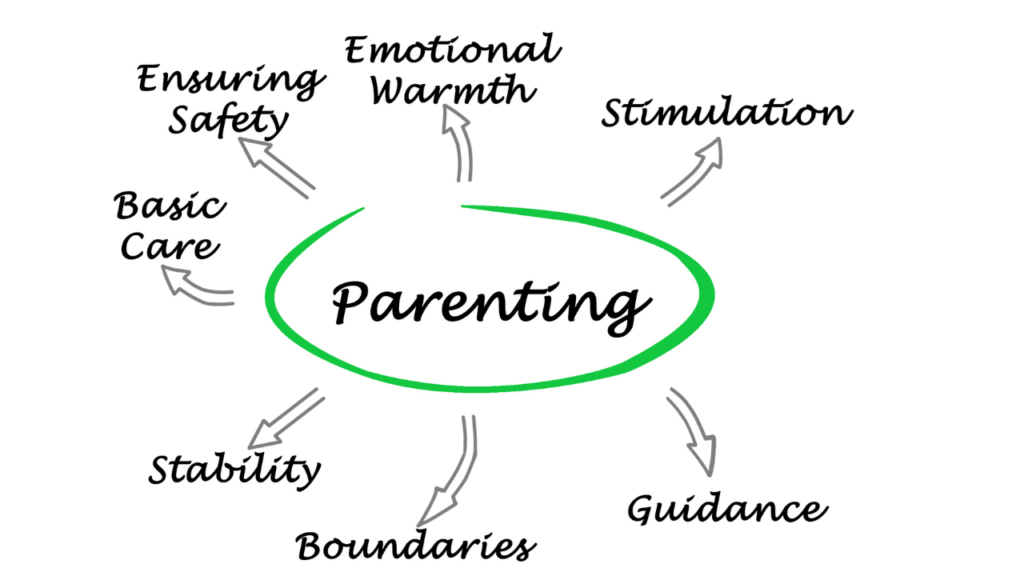Gentle parenting is an approach to child-rearing rooted in respect, empathy, and non-violence. Let’s explore the principles, advantages, and disadvantages of this parenting style. Understanding gentle parenting is crucial in the modern age of diverse parenting approaches.
Table of Contents
Understanding Gentle Parenting

Definition and Core Principles
Gentle parenting is defined by several core principles. Firstly, it emphasizes non-violence and empathy as the cornerstone of interactions with children. Rather than resorting to physical or emotional harm, gentle parents prioritize understanding and nurturing their child’s emotions and mental health.
Respect for the child’s autonomy is another vital principle. This means allowing children to have a voice and make choices within safe boundaries. It fosters independence and self-confidence.
Mindful parenting communication is at the heart of parenting. Parents employ active listening, use positive language, and focus on problem-solving without resorting to punishment. This encourages healthy dialogue and emotional growth in children.
Setting boundaries with understanding is the final principle. Rather than strict rules imposed without explanation, gentle parents guide their children by explaining the rationale behind the rules. This approach fosters a sense of trust and mutual respect.
How to Implement Gentle Parenting

Building a Nurturing Relationship
Building a nurturing relationship begins with bonding with your child. Spend quality time with them, and engage in activities that strengthen your emotional connection. The secure attachment formed in early childhood has a lasting impact on a child’s emotional well-being.
Developing emotional intelligence is equally important. Teach your child to recognize and express their emotions in a healthy way. Help them understand that all feelings are valid, but some behaviors may need adjustment.
Effective Communication Strategies
Positive parenting thrives on effective communication. Active listening is key. Give your child your full attention, and validate their feelings. This fosters trust and open dialogue.
Using positive language is another essential component. Instead of saying, “Don’t do that,” say, “Let’s try this instead.” This approach encourages cooperation and reduces resistance.
Problem-solving without punishment is a central aspect of parenting. When issues arise, involve your child in finding solutions. This helps them learn how to handle challenges independently.

Problem-solving without punishment is a cornerstone of gentle parenting. Rather than resorting to punitive measures, parents and children collaborate to find solutions to issues, teaching children valuable conflict resolution skills.
Setting Age-Appropriate Boundaries
Discipline without punishment is a cornerstone of gentle parenting. Instead of punitive measures, focus on natural consequences. For example, if a child refuses to wear a jacket, they’ll feel cold, which teaches responsibility and the importance of decision-making.
Using natural consequences helps children learn personal responsibility and accountability. For instance, if a child refuses to wear a coat in cold weather, they may feel cold, allowing them to understand the importance of dressing appropriately.
Encouraging independence and self-regulation
Gentle parents promotes independence and self-regulation by teaching children responsibility and allowing them choices within certain limits. Parents guide their children to become self-sufficient and develop decision-making skills.
Teaching responsibility involves age-appropriate chores and tasks. Children learn to contribute to the family and understand the importance of responsibility. Allowing choices within limits grants children a sense of control while ensuring they make safe and appropriate decisions.
Importance of discussing parenting styles

Understanding different parenting styles is crucial for fostering healthy child development and maintaining strong parent-child relationships.
Purpose of the Article
This comprehensive guide aims to explore the principles, advantages, and disadvantages of gentle parenting. We will delve into the practical aspects of implementing this approach, discuss real-world challenges, and provide examples and success stories. Additionally, we will address frequently asked questions and offer a recap and checklist for parents looking to adopt gentle parenting techniques.
Parenting revolves around four core principles: non-violence, empathy, respect for a child’s autonomy, and positive communication. It involves setting boundaries with understanding.
Advantages of Gentle Parenting

A. Healthy child development
Fosters healthy child development by prioritizing emotional intelligence and resilience. Children raised with empathy and respect learn to manage their emotions effectively and handle life’s challenges.
This approach also cultivates positive self-esteem. Children who are valued and respected by their parents develop a strong sense of self-worth.
B. Strong parent-child relationships
Trust and open communication are the pillars of strong parent-child relationships in gentle parenting. Children who feel heard and understood are more likely to trust their parents and seek their guidance.
Reduced power struggles are another significant advantage. When children are involved in problem-solving and decision-making, conflicts decrease, and the parent-child relationship becomes more harmonious.
C. Long-term behavioral benefits
Gentle parenting yields long-term behavioral benefits, including fewer behavior problems. Children raised with empathy and respect are less likely to engage in disruptive or aggressive behaviors.
Enhanced problem-solving skills are also a byproduct of this parenting approach. Children learn to address challenges through constructive means rather than resorting to negative behaviors.
D. Reduced stress for both parents and children

It’s reduces stress for both parents and children. Parents who communicate positively and avoid harsh discipline experience lower levels of anxiety and tension.
The overall family well-being improves as a result of reduced conflict and stress. Children raised in a gentle parenting environment tend to be happier and more secure.
Disadvantages of Gentle Parenting

A. Time and energy demands
Positive parenting demands patience and consistency. Parents must invest time and effort into building a nurturing relationship and effectively communicating with their children.
It may involve more active problem-solving, which can be time-consuming. Parents need to be available to engage in discussions and find solutions to conflicts.
B. Challenges in dealing with difficult behaviors

Positive parenting faces challenges when dealing with difficult behaviors. Instead of resorting to punitive methods, parents need to find alternative discipline approaches that are effective.
Dealing with external pressures, such as peer influence and school expectations, can be complex. Parents may need to navigate societal expectations that favor more traditional disciplinary methods.
C. Potential misconceptions and criticism
Misunderstandings about permissiveness are a common challenge for parents practicing gentle parenting. Critics may wrongly assume that it involves indulgence or leniency.
Navigating societal expectations can be challenging, as well. Some parents may face criticism from family or friends who have different views on parenting. It can be emotionally taxing to defend the gentle parenting approach.
Balancing Gentle Parenting with Real-World Challenges

A. Adapting to individual child’s needs
Adapting gentle parenting to an individual child’s needs is crucial. Parents must tailor the approach to the child’s personality, recognizing that each child is unique.
Special considerations may be required for children with specific needs, such as developmental disorders or behavioral challenges. Gentle parenting can be adjusted to accommodate these needs.
B. Combining gentle parenting with discipline
Balancing gentle parenting with discipline is essential. This involves setting clear expectations for behavior and using strategies to handle challenging behaviors effectively.
The role of clear expectations is to ensure that children understand the boundaries and the consequences of their actions. Strategies for handling challenging behaviors may include time-outs, logical consequences, or loss of privileges, all implemented without resorting to violence or harsh punishments.
Real-Life Examples and Success Stories

A. Anecdotal experiences of parents practicing gentle parenting
Many parents have successfully embraced gentle parenting and have shared their experiences. They have noted improved relationships with their children and reduced conflict in their homes.
By avoiding punitive measures and prioritizing empathy and communication, these parents have found that their children are more cooperative and emotionally balanced.
B. Research findings and case studies
Research supports the benefits of gentle parenting. Studies have shown that children raised in such environments tend to have better emotional regulation, higher self-esteem, and reduced behavioral issues.
Case studies also illustrate the positive impact of gentle parenting on children’s development and overall family well-being.
FAQ
Common questions and answers about gentle parenting
Is gentle parenting the same as permissive parenting?
No, gentle parenting emphasizes setting boundaries and discipline while respecting the child’s autonomy. Permissive parenting tends to be more lenient with fewer rules and less discipline.
How can I implement gentle parenting with a strong-willed child?
With a strong-willed child, it’s important to maintain consistent boundaries and offer choices within those boundaries. Communication and problem-solving skills are vital.
Can I use gentle parenting in different cultural contexts?
Yes, gentle parenting can be adapted to various cultural contexts. The core principles of empathy, respect, and positive communication remain universally applicable.
What should I do if I face criticism from family or friends regarding my parenting style?
It’s important to explain your parenting philosophy to your loved ones and educate them on the benefits of gentle parenting. Seek support from like-minded individuals or parenting groups.
Conclusion, Recap, and Checklist
Recap of Gentle Parenting principles

It’s revolves around four core principles: non-violence and empathy, respect for a child’s autonomy, positive communication, and setting boundaries with understanding.
Reiteration of advantages and disadvantages
The advantages of gentle parenting include healthy child development, strong parent-child relationships, long-term behavioral benefits, and reduced stress. However, it comes with time and energy demands, challenges in dealing with difficult behaviors, and potential misconceptions and criticism.
Gentle Parenting Checklist
1. Foster empathy and non-violence in your interactions.
2. Respect your child’s autonomy and choices.
3. Communicate positively and actively listen.
4. Set age-appropriate boundaries without punishment.
5. Encourage independence and self-regulation.
In conclusion, gentle parenting is an approach that prioritizes empathy, respect, and understanding in raising children. By implementing its principles, parents can promote healthy child development, build strong relationships, and cultivate long-term behavioral benefits while reducing stress. Despite gentle parenting pros and cons, parenting offers a nurturing and effective way to raise children.
This article provides a comprehensive resource for understanding and adopting positive parenting, offering insights into its principles, advantages, and disadvantages, as well as guidance on practical implementation and addressing real-world challenges.


